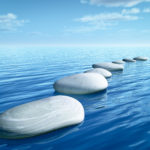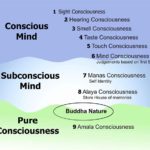Transcript download: lesser greater self 1
What is the Nichiren perspective is on ego or no self. Is the aim to fully dissolve the personal self? Is it an illusion we have an ego? Are we to upgrade the self or see it as non-existent? I’ve never fully understood this topic.
This is an interesting question and illustrates the confusion that can develop when we have heard the ideas of another form of Buddhism and don’t know how they equate to our own practice. Your question is relating to the Theraveda or the Tibetian form of Buddhism.
Theravada Buddhism – View of Desires
I am not knowledgeable about this form of Buddhism so all my information on Theravada Buddhism comes from the Soka Gakkai Dictionary of Buddhism.
In Theravada Buddhism, earthly desires and the cycle of birth and death are seen as sources of suffering and obstacles to enlightenment. The goal is to eliminate all desires and end the cycle of death and rebirth to enter nirvana. Nirvana in this form is extinction, emancipation, cessation and non-rebirth. The Soka Gakkai Dict of Buddhism, p. 458.
The goal of practice can only be achieved at death, when both body and mind, the sources of suffering are extinguished.
Theravada Buddhists believed Shakyamuni lived at a level way above ordinary people, so ordinary people couldn’t attain Buddhahood.
Their goal was the highest state was that of arhat. An arhat is one who has attained the highest of the four stages that voice hearers aim to achieve. The arhat no longer has the illusions of thought and desire and has freed himself from rebirth in the six lower paths. Dict of Buddhism, p. 23.
Small numbers of monks, who withdrew into mountain top monasteries practiced towards this end.
Mahayana Buddhism – View of Desires
In Mahayana Buddhism our branch, desires are seen as a function of life. They can be used as steppingstones to enlightenment, when we chant about them based on the Mystic Law. The energy of earthly desires can be elevated and transformed into shining wisdom and compassion and can be redirected to a higher level that transcends the individual and benefits others. You don’t try to rid yourself of desires. You transmute them.
The Lotus Sutra teaches that every person has the Buddha nature and can become enlightened as Shakayamuni did.
Nichiren Buddhism teaches that by awakening to one’s Buddha nature, one can reach nirvana in one’s present form. Nirvana is not a cessation of birth and death, but rather ajoyful state of enlightenment experienced as one repeats the cycle of birth and death.
Enlightenment is something every individual has the capacity to achieve. It is not restricted to certain types of people.
Nichiren Buddhists do not retreat from the world, but practice engaged Buddhism. This practice plants one’s feet firmly in this world.
The Nine levels of Consciousness
Before we can discuss the ego and the greater self, I want to cover the nine levels of consciousness as taught in Nichiren Buddhism to put this discussion in context. Heritage of the Ultimate Law of life, p.92
The first five are the levels of the senses.
The 6th is the level of mind where we integrate and evaluate information from the senses, in order to understand the physical environment.
The seventh level is one of inner-directed awareness wherein the understanding of and attachment to the concept of self arises.
The eighth is the storehouse of past causes from this life and previous lives.
The ninth is a level of pure consciousness free from any karmic defilement. It is “the unchanging reality that rules over all of life’s functions” The Real Aspect of the Gohonzon, WND -1, 832 This is the amala-consciousness and represents the Mystic Law or Nam-myoho-renge-kyo. For a fuller discussion on the Mystic Law go to my vlog“Why Is It Important to Have Faith in the Gohonzon? “at https://wp.me/p3V1J9-110
Theravada Buddhism – View of the Ego
The way I see it, Theravada Buddhists were trying to rid themselves of the ego with its attachment to desires and thus to suffering. They wanted to raise their level of consciousness in order to live in that level of pure consciousness, the non-self , the transcendental field underlying the phenomenal world and the basis of everything. Long hours of meditation were devoted to this but to focus one’s awareness there mean’t that you couldn’t function in the world, but had to retreat from the world to live in a monastery in the mountains.
The first eight levels of consciousness stop functioning when we die. At that time our individual manifestation in the material world ends. This is like the wave returning into the ocean. In death, our awareness returns to the expanded level of amala-consciousness,the Mystic Law. Our awareness once again becomes the ocean. It appears that Theravada Budddhists were trying to live at level of life.
Mahayana Buddhism – View of the Ego
The Lesser Self
The ego is considered the lesser self. It has a narrow self-interest, focused on personal desires. The lesser self functions in the lower worlds and tends to lack compassion. The individual living in the lesser self has a sense of separation, of having to be on his/her own. The ego doesn’t have access to the ocean of wisdom but possesses only limited wisdom. It is subject to negativity, ingratitude and has no awareness of its connection with the Mystic Law . When we are living in the lesser self we are living in fundamental darkness.
When living in the lesser self, we are buffeted by the ups and downs of life and live with fears, constantly reacting to praise and censure.
When we are living in the greater self, we are fully aware of and base our actions on the Mystic Law. It is a state of “boundless freedom that pervades the entire universe.” When living in the greater self we become compassionate and have concern for others wanting to relieve them of suffering. We regard the happiness of others as our own.
When the self is based on the Mystic law, “ The energy of earthly desires can be elevated and transformed into shining wisdom and compassion; it can be powerfully redirected to a higher level that transcends the individual and benefits everyone around them.“ The
Wisdom for Creating Happiness and Peace, part 2, 47-49.
When living in the greater self, the individual treasures the law more highly than their own life.
When we live in the greater self, we are not swayed by changing phenomena and is not subject to the ups and downs of life, as we are grounded on the rock of the eternal unchanging law. You have boundless appreciation at the core of your life and you have awakened to the fact that you are eternal.
When you live in the greater self. you have access to an ocean of wisdom which flows in your life. You live in a state of freedom as vast as the universe, imparting joy to
everyone around you.
Nichiren Buddhism does not teach a doctrine of non self. Instead it teaches that one should illuminate ones life through tapping into the Mystic Law. Base one’s life on the 9th consciousness and act in the 6th. As the level of self-identity, the 7th level, is formed when we are born, it is needed to function in this world. But the ego can be lived at lower or higher levels.
As we chant and connect with the Mystic Law day after day, our lesser self gradually opens into the greater self. spontaneously and naturally. You don’t have to go through arduous practices. When we tap into the amala-consciousness we illuminate the other levels of consciousness as we take action for our own happiness and that of others.
Heritage of the Ultimate Law of Life, p. 92
Summary:
To summarize, in Nichiren Buddhism you don’t have to go through arduous practices to elevate the lesser self into the greater. Nor do you have to retreat from the world. You don’t have to spend hours and hours in meditation. Instead, you tap into the Mystic Law day after day and illuminate the lesser self with the light of the Mystic Law. Although we can go back and forth between the lesser and greater selves, I believe that over time, you live longer and longer periods in the greater self.
Other Related Vlogs
1. “Why Is It Important to Have Faith in the Gohonzon? “ https://wp.me/p3V1J9-
110
2. Know the wonderful Cluster of Blessings Brought by Nam-myoho-renge-kyo?
https://wp.me/p3V1J9-Ww
3. Steps to forge Your Faith https://wp.me/p3V1J9-VX
Comments;
As always I am always interested in what you have to say and your suggestions for topics you’d like to hear about.
See you in two weeks.




